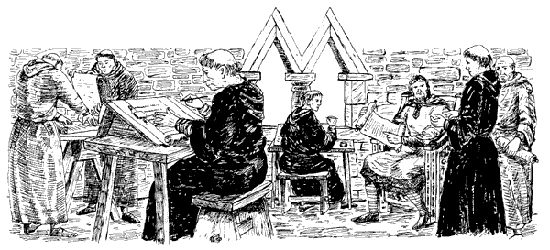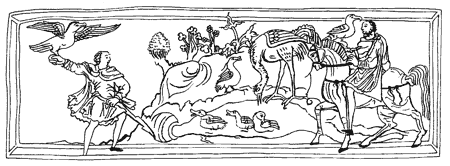 |
Books and manuscripts were produced by in the Scriptorium by monks who also copied many other important documents for legal work, wills etc. Most documents were copied at least twice, so that a copy could be stored in the monastery and the other with the landowner, for example. Prior to the world of the printer, the monks were the only source of reading material that could be duplicated for use up and down the country. The most famous were the religious texts, but the most important at the time were the legal records and ownership documents. These were written in Anglo-Saxon, the spoken tongue, rather than Latin which was the language of the church. It of course took quite some months to copy a book, but a skilled copyist could manage a document much more quickly. The rule of thumb was much the same then as now; the more colour and detail, the longer it took.
 |
Depending upon the commissioner of a book or document, the monks were allowed to inject their own style and humour if appropriate. The Harley Psalter drawn in the 10th century, is a direct or certainly no further than third generation copy of a book called the Utrecht Psalter from Holland. This is dated to the early 9th century by the style of illumination and the calligraphy. It is not a slavish copy, with the text and the scenes being the same, however, there are many items that casually litter the Harley version that do not appear in the Utrecht one. Roof tiles or shingles decorate buildings in the Harley where none existed previously. Saws, weather cocks, pots and pans, numerous things that suggest that the monk who 'copied' out this work was drawing from things he saw around him, as there were none in the previous version. What prompted him to do this is anyone's guess, as they do not aid the telling of the stories.
Another example are the Calendars that were collected together in the 1700's by Cotton, who to aid his memory in the library, named each row of shelves after a Roman Caesar. Hence, the Tiberius Calendar and the Julian Calendar. On first inspection, the obvious thing is that the Tiberius version is in colour and the Julian is black and white.
 |
The subject matter is the important part, as each month is a guide to what agricultural practise is supposed to be performed in each month, in very broad terms that is. The Tiberius is executed with an impression of the monk having witnessed the activities himself. All the faces of the workers have character, although things are too clean and the trees are still stylised to some extent. The Julian is in a freer hand, more in the vein of the previously mentioned Harley Psalter, without that done on site feel to it, (my personal opinion), but none the worse for that. These two works do in two instances disagree about what should be done when, but are in broad agreement in all others. In fact, there are other versions of these calendars on the continent, which interestingly also disagree with the English versions a little. The time to prune vines is one example. In the Tiberius calendar this is shown occurring in February as opposed to later in the year. The explanation could lie in the fact that the growing seasons here differ from those in southern Europe suggesting that the calendars here may have been adjusted to suit agricultural practice in our wetter northerly climes.
The monks also had to deal with the problems of poorer weather through the autumn to spring, when the drop in temperature could freeze the ink and pigments. This required the ink to be warmed with a low flame before use. The Anglo-Saxon Chronicles demonstrate the handwork of several monks as the record was expanded over the years. Good storage was of great concern as well. Many insects and their larvae enjoy consuming vellum. There are some pages of manuscript that have woodworm holes through them, where the grubs had chewed their way from one oak endboard of the book, through the pages to the other, resembling the work of a shotgun. Although it is mostly the hand-written pages that survive today, enough covers and endboards have been preserved to enable us to reconstruct how the bookbindings were originally constructed.
Click here to return to the St. Werberg's Mynster.